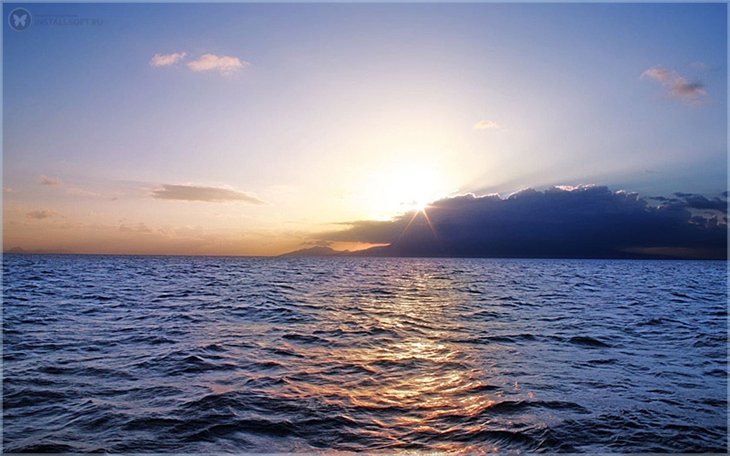Caspian Sea environment requires measures, expert says

By Vusala Abbasova
The water level in the Caspian Sea has decreased considerably over the past ten years, extending the coastal area.
The change in the water level on the Caspian Sea enacts significant changes to the landscape of the shore and has created a greater area for the fabulous Baku seashore boulevard.
The Caspian Sea level has decreased by 28 meters over the past 10 years due to climatic changes, said Ramiz Mammadov, the director of the Geography Institute at the Azerbaijani National Academy of Sciences.
"The level of the Caspian Sea, which is located below the world ocean level, is minus 28 meters," he told AzerNews.
The Caspian is considered the largest closed lake on the planet, with an area of 371,000 square kilometers, brackish water, and features similar to those of a sea, since it has a maximum depth of 1,025 meters.
Measurements of the water level in the Caspian Sea have shown that in the first century, the sea level had remained roughly unchanged from 1837 to 1930, ranging between minus 25 and minus 26 meters, according to Window to Baku portal.
A sharp drop of nearly two meters, from minus 25.88 to minus 27.84 meters, could be seen in the period from 1929 to 1941, and the water level was recorded at minus 29.01 meters in 1977.
Then, the water level in the sea dropped to the level of minus 26.66 meters by 1995 and reached minus 27.17 meters in 2001.
The water level in the Caspian Sea has decreased by 0.56 meters, reaching 27.43 meters in 2014, according to the Baltic system of heights.
Natural changes effect significant fluctuations in the Caspian Sea, washing the coasts of Azerbaijan, Russia, Kazakhstan, Turkmenistan and the Islamic Republic of Iran.
Changes in height of sea level are connected to the climate fluctuations in the Caspian’s tributaries—the Volga, Urals, Samur, Kura, Terek and Sefidrud river basins—constituting about 80 percent of the Caspian Sea water balance.
Each beach has its own water balance, which includes rivers flowing into it, precipitation and evaporation from the surface, said Mammadov.
"Any change in the water balance brings alternations into the sea level," he noted.
The Volga River, with a capacity of 200 cubic kilometers remains a major source of water for the Caspian. River capacity can be seen declining when compared to its previous capacity of 300 cubic kilometers.
With regards to the Caspian Sea environment, which is on the countries’ sustainability agenda, Mammadov stressed that the conditions for sea pollution date back to the Soviet Union.
"Today's stressful ecological state of the Caspian Sea is connected with extensive development of the economy of the Caspian region's industry," Mammadov said.
In his opinion, the rivers and sea pollution are related to the Caspian’s uncertain international legal status, maritime traffic, and coastal industrial facilities. The new sources of pollution are being created as a result of the changing sea level, which floods coastal areas. Pesticides, used in agriculture since Soviet times, wash into the Caspian’s tributaries (rivers) and flow into the sea, affecting its ecological state.
Mammadov sees a solution to the ecological problem in the large-scale program, which would integrate all coastal countries.
The program can be based on the Regional International Tehran Convention on the Caspian Sea’s recommendations on marine environment protection from pollution, including the protection, conservation, restoration and sustainable and rational use of the biological resources signed in 2003among the five littoral countries.
If the existing Convention includes the program, where the main condition would be zero discharge into the Caspian Sea, then the sea ecology problem would be resolved in the near future, Mammadov said.
The zero discharge quota includes a ban on dumping oil and gas products into the Caspian Sea, and regulates maritime traffic pollution and the pollution from the coastal area facilities.
The full program should be implemented in compliance with a modern tracking system for the Caspian Sea.
The professor noted that special attention should be given to the monitoring, which would be carried out by different facilities, including remote monitoring by satellites, and observation mechanisms on the ground.
"Such program will naturally create rapid information transfer on the state of the marine environment. It is a great work with big spending and lots of agreements," said Mammadov.
In his view, the program enacted by Baltic Sea countries can serve as a model.
The EU endorsed the EU Strategy for the Baltic Sea Region in October 2009, under which EU Member States, EU regions, trans-Baltic organizations, financing institutions, and non-governmental organizations agreed to promote a more balanced development of the region.
The Caspian’s lingering unsettled status is an impediment to tackling the environmental problems of the sea.
The international legal status of the Caspian Sea became one of the most controversial issues facing the coastal countries of the region since the collapse of the Soviet Union. The discovery of a large number of oil and gas deposits under the seabed has increased need to resolve the issue.
The environment is the air we breathe, the water we drink, and the land on which our food grows. In answering questions such as "what does the environment mean for our lives and why we should protect it?" we do not always notice how we relate to the land and to each other.
---
Follow us on Twitter @AzerNewsAz
Here we are to serve you with news right now. It does not cost much, but worth your attention.
Choose to support open, independent, quality journalism and subscribe on a monthly basis.
By subscribing to our online newspaper, you can have full digital access to all news, analysis, and much more.
You can also follow AzerNEWS on Twitter @AzerNewsAz or Facebook @AzerNewsNewspaper
Thank you!
